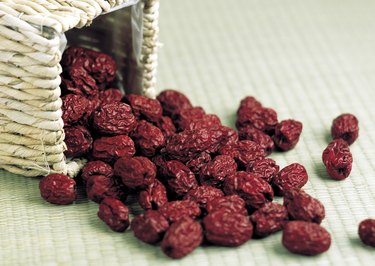
Date palm trees (Phoenix dactylifera) are natives of the North African deserts where the trees have been in cultivation for thousands of years for their fruit. Dates are consumed both in their fresh and dried form. Date palms produce their male and female flowers on separate trees, and pollination occurs primarily through wind. Dates are prone to the sooty black mold that indicates the presence of a pest on the tree.
Pest Identification
Video of the Day
Palm aphids are common pests of palm trees, including date palms. The insects are native to Asia but are now spread throughout the tropical, humid, palm growing areas of the world, including Florida. In its native range, the palm aphid also forms galls on certain broadleaf trees. However, in the United States, the insects exclusively infest palm trees.
Video of the Day
Description
Palm aphids are small, wingless pests measuring about 1/16 inch long. The insects have functional legs and slightly convex, oval bodies. There is a waxy, white fringe around the dark brown body. The insects primarily infest the undersides of young foliage and gradually also spread to other areas, such as fruit. The young or the nymphs are light green to olive colored and similar in shape to adults.
Damage
The aphids have specialized, sucking mouth parts that they use to suck plant juice or sap from tender plant areas, including the fruits. As they feed, the pests produce a large amount of sugary, sweet, sticky honeydew that covers infested plant areas. This honeydew leads to the growth of the sooty black mold on dates and foliage. Excessive feeding yellows foliage and damages fruit. The black mold coating reduces photosynthesis in the foliage.
Management
Introducing natural predators in infested trees helps provide biological control. These include the syrphid fly larva and the lady beetle larva. Examine trees frequently to control infestation in early stages. The use of horticultural oil is often enough to control light populations. Recommended pesticides include products containing acetamiprid, acephate, thiomethoxam, imidaclorid or dinotefuran. Insecticides are distinguished for landscape or nursery use. Check the label before purchase.